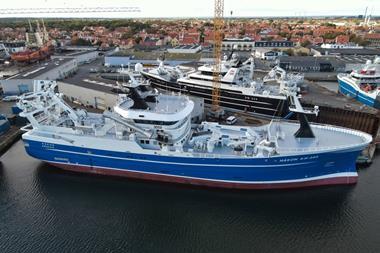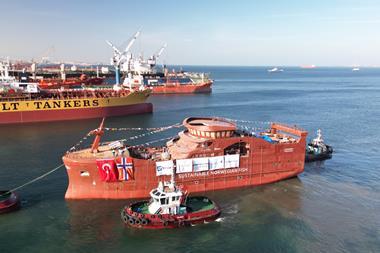In engineering its new Twister pelagic doors, Vónin started from the same principles as the highly successful Tornado design. In addition to that, it has incorporated shutters that allow the lift force from the flow to be altered on the lower and upper part of the trawl door.
Designed for low drag and high efficiency, the new Twisters have already surpassed previous designs in terms of spreading force and are prepared for an active control system that will make them the first-ever smart doors.
They were put through a tough testing process to ensure that they did everything the calculations had predicted – and they did, generating even better spreading force than the Tornado doors, reports Vónin, which believes that the CL of the Twister doors at 4.39 is the highest of any trawl doors on the market, and the CL/CD value varies between 3.16 and 3.60, depending on the shutter settings and the angle of attack. Shutter settings have very little effect on the CL/CD values of the doors, meaning the Twisters will be lighter to tow when lift (CL) is decreased.
The stability of the Twister doors goes with a high flexibility range. These have been used across several pelagic fisheries, from working on highly dispersed fish at depth, to chasing elusive marks of fast-moving mackerel just a few metres beneath the surface.
Flexibility is due to the versatile shutters that alter the flow of water passing between two of the sets of foils, with each door fitted with upper and lower shutters. This offers settings for greater or lesser spreading force, while also providing options for the doors to be set to seek up or down in the water column.
A straightforward crank arrangement allows the shutters to be adjusted easily by a single crewman with the doors at the stern. This patent-pending arrangement means that there are no shackles that need to be moved to adjust the doors.
Vónin has its own approach to controllable trawl doors with the Smart concept. Twister doors are already prepared for the installation of this Smart system in which the doors poll each other for spread. Combined with depth sensors, the doors have a situational awareness that enables them to respond according to their programming, with setting options for various fisheries.
Skippers can manage door settings from a smartphone or tablet app, and by making the doors capable of responding to changing circumstances autonomously, there is no need for a hull-mounted transducer and no ship-to-gear communication challenges.
Caption: In trials, the Twister pelagic doors generated better spreading force than Tornado doors








